Highlights from the HPLC 2015 Symposium
LCGC North America
HPLC 2015, chaired by Gérard Hopfgartner was held in Geneva, Switzerland, from June 21–25. This installment covers some of the highlights observed at the symposium including stationary phase developments, particle technology, and areas of growing application of HPLC. In addition, trends and perspectives on future developments in HPLC culled from the conference are presented.
The 42nd International Symposium of High Performance Liquid Phase Separations and Related Techniques, or HPLC 2015, convened in Geneva, Switzerland, on June 21–25, 2015. The conference was held at the International Conference Center Geneva (CICG) in the very country that the conference began in 1973 (Interlaken). This conference, which has grown into the premier event bringing together leading scientists in the field of liquid separations, attracted about 1100 delegates from 50 countries. This was a considerable increase compared to HPLC 2014 in New Orleans, Louisiana, but similar in numbers to previous European events. HPLC 2015 was chaired by Professor Gérard Hopfgartner of the University of Geneva and emphasized fundamental aspects of separations sciences, sample preparation, novel developments and applications as well as hyphenation with mass spectrometry (MS).
The conference included 169 oral presentations including several plenary lectures and sections dedicated to Professor Georges Guiochon, who sadly passed away on October 21, 2014. There were also 560 poster presentations and several short courses, vendor seminars, and tutorials within the vast program. In this installment of “Column Watch,” observed highlights and trends from the conference are reported.
Oral Presentation Highlights and TrendsTrends in Liquid Separations
Figure 1 provides a breakdown of the categorization of the presented oral lectures at the meeting. Although the HPLC technique continues to dominate, several areas of increased emphasis are noted. Much like HPLC 2014 where the conference took on the personality of its chair, Professor Michael Ramsey, and a consequent increase in microseparations was observed, this year a strong emphasis was placed on liquid chromatography coupled with mass spectrometry (LC–MS). Techniques such as capillary electrophoresis (along with related techniques) and supercritical fluid chromatography (SFC) have continued to grow in popularity over the past several conferences. Microseparations, although not as prevalent as last year, continue to hold a strong position within the field. Multidimensional HPLC continues to see a rise in popularity and is finding application in areas such as food science, proteomics, metabolomics, and many others. In terms of specific application areas, the oral presentations were heavily dedicated toward large-molecule separations including special sections of biopharmaceuticals and phosphoproteomics. Pre- and post-separation requirements were also well represented within the oral sessions. Sample preparation was well represented not only within the specific sample preparation sections, but also throughout the symposium. Data analysis and design of experiments were likewise discussed in a number of sessions.
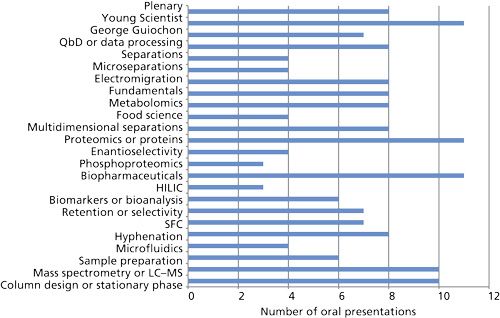
Figure 2 presents a rough breakdown of the separations techniques presented during the oral sessions. As noted previously, the conference was heavily stacked with presentations related to MS. HPLC column technology, developments, and fundamentals continue to be a cornerstone of the conference series; however, this area was not as dominant as it has been in the past. SFC, which laid rather dormant for much of the 2000s, has gained in popularity over the past several years. The increase in interest is likely because of the improvement of instrumentation, the recognition of applicability to mainstream separations and the desire for “greener” technologies. Likewise, multidimensional chromatography continues to increase its presence at the HPLC symposia. An improved understanding of fundamentals, commercially available instrumentation and software, along with the ever-increasing complexity of samples seems to have driven the technique to new heights. Electrophoretically driven techniques continue to show a strong presence with an increase in protein and peptide separations within the technique. Although understandably down from last year, microseparation techniques continue to be an integral part of the HPLC conference. Thin-layer chromatography (TLC) was mentioned a few times during the symposium, especially when related to TLC–MS. This may be a sign of an increased interest in this classical technique.
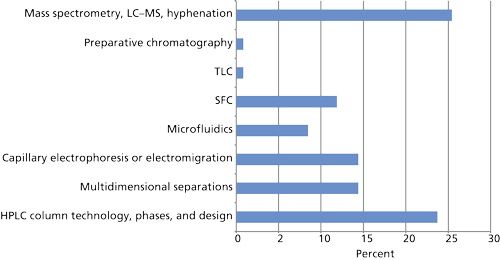
Digging a little deeper into HPLC technologies, Figure 3 lists oral sessions that specifically called out the use of HPLC modes of chromatography. Reversed-phase LC continues to be the dominant technique, however, more specialized techniques such as hydrophilic-interaction chromatography (HILIC) and chiral modes were well represented. HILIC has become increasingly popular over the past decade as it can retain and separate polar molecules that are difficult to deal with in reversed-phase LC. Issues with reproducibility and long equilibration times in HILIC have prompted much research into the fundamental retention mechanisms and dynamics. James Heaton, PhD, for example, presented a lecture noting some of the issues associated with the multitude of interactions that occur in HILIC (1). Heaton demonstrated deleterious effects of chelation using a set of catecholamines. He also noted issues with certain sample solvents and showed the impact of buffer concentration in the mobile phase on retention and peak shape of certain compounds. The area of chiral separations has also seen some resurgence. Areas of chiral research not only include pharmaceutical concerns, but also areas of metabolomics, agriculture, and food science, to name a few. Size exclusion chromatography (SEC), ion-exchange chromatography, and affinity chromatography all appear to be increasing in popularity within the oral sessions at HPLC. This trend likely parallels the increase in large-molecule separations interest as noted in sections to follow.

One of the major areas of interest in HPLC over the past decade has been in the development of improved particle technologies. Figure 4 shows a rough breakdown of the particle technologies highlighted during the oral sessions at HPLC this year. Sub-2-µm or ultrahigh-pressure liquid chromatography (UHPLC) technology continues to be a dominant area of interest. Superficially porous particles (SPPs) also made a strong showing. Both technologies appear to have matured for the most part and, as mentioned by Tividar Farkas in his presentation (2), most current efforts in these technologies appear to be focused on alternative chemical modifications and expansion into niche areas (3).
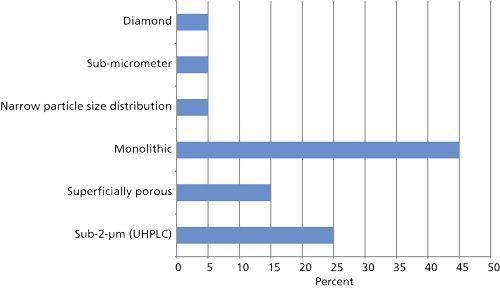
An excellent presentation by William Barber demonstrated that further innovative efforts in preparing SPP particles are continuing. Barber described a patented preparation of highly ordered pores through a process called pseudomorphic transformation (PMT) and compared this process to standard preparations of superficially porous materials (4). Figure 5 shows the resulting highly ordered pore structure that is obtained using this process.
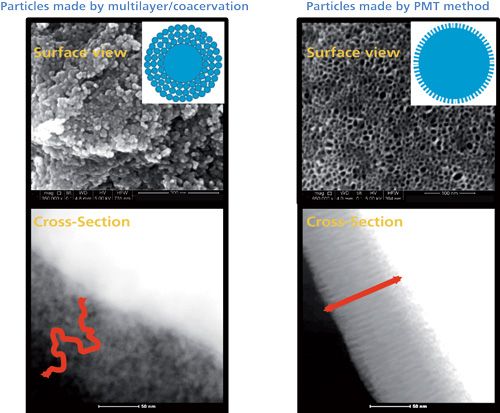
Barber went on to describe the high efficiencies that are obtained when these particles are packed in HPLC columns. These high efficiencies are expected to be a result of the diffusion pathways resulting from the ordered pore structure. In another interesting presentation, Alberto Cavazzini covered the development of narrow particle size fully porous sub-2-µm particles (5). These particles, when packed in HPLC columns, were shown to produce high efficiencies of about 300,000 theoretical plates/m as shown in Figure 6. Detailed studies investigating the origin of the high efficiency concluded that the A term of the van Deemter equation for the narrow particle size particles was smaller than that for columns packed with particles with a more disperse particle size. Although monolithic HPLC columns continue to be commercially available from a few sources, research in this area continues to grow. In a similar fashion to developments in fully porous and superficially porous technologies, monoliths continue to be modified with new chemistries to improve selectivity space and application in an abundance of arenas.
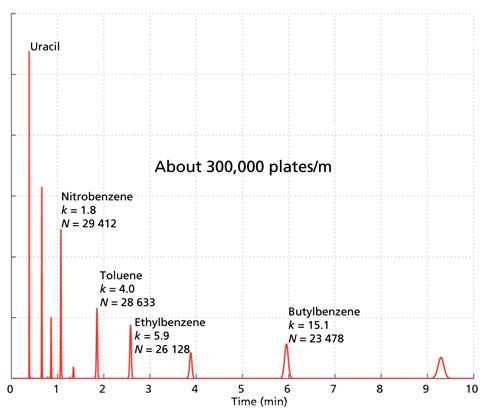
Figure 7 provides a breakdown of the primary application areas discussed during the oral sessions. It is clearly apparent that large-molecule separations dominated discussions where separations were applied. There were even a few specialized sessions on specific large (or larger) molecules such as phosphopeptides and biopharmaceuticals. Dwight Stoll presented an interesting lecture on the characterization of monoclonal antibodies (mAbs) using multidimensional chromatographic approaches (6). The complexity of mAbs necessitates the use of a number of techniques to adequately characterize them. Stoll explained some of the complexity, noting that variations in glycosylation, oxidation, and isomerization of mAbs led to an estimated 108 different molecular forms.

He went on to compare different forms of multidimensional LC separation techniques including heart-cutting as well as comprehensive and selective two-dimensional (2D) LC. Selective 2D-LC as depicted in Figure 8 was shown to be a powerful and flexible approach that enables the acquisition of multiple dimensions of chromatographic information for mAbs in a single analysis. When coupled with MS, molecular information can also be obtained directly in the same analysis.
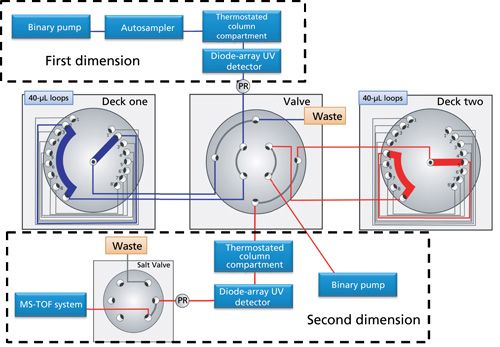
Several talks focused on techniques for sample preparation of mAbs and alternative techniques of analysis, such as Chervet’s discussion regarding the use of electrochemical reduction of disulfide bonds coupled with MS (7). Barry Karger discussed glycoprotein structural characterization using top-down high-resolution capillary zone electrophoresis coupled to mass spectrometry (CZE-MS) (8). From these few examples, it is clear that the focus on the analysis of large molecules will continue to bring alternative sample preparation, separation, and detection techniques to the forefront of future HPLC meetings. On the small-molecule side, biomarkers, bioanalysis (namely the analysis of small molecules in biological fluids), and metabolomics are areas of high interest. The complexity of the separations and the matrices being investigated also necessitate improvements in sample preparation, separation efficiencies, alternative selectivity, and novel detection schemes. Research in each of these areas is expected to continue and play a large role in future HPLC programs. Other areas of significant interest included pharmaceutical, environmental, and industrial applications.
Poster Presentation Highlights and Trends
Trends in Liquid Separations
Poster presentations are a vital component of the HPLC symposia. This is evidenced by the 560 posters that were presented at HPLC 2015 in 27 session topics. Half of them were presented on Monday and Tuesday and the other half were presented on Wednesday and Thursday. The conferees have three breaks between talks in each day to see the posters and interact with the authors. The number of posters presented at HPLC 2015 increased 30% compared to HPLC 2014 in New Orleans (Table I). Clearly, HPLC 2013 was an “outlier” since it had almost twice the number of posters than the adjacent years, which was consistent with its higher attendance compared to the other years.
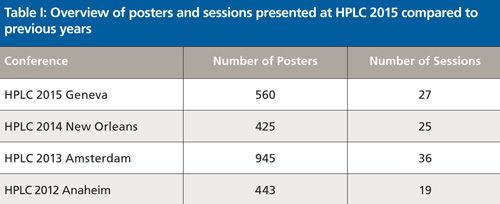
The number of posters in each session topic is shown in Figure 9. The two busiest session topics were LC–MS and column design or stationary phase with 58 posters each. This highlights the continuous trend in coupling LC and MS and the never-slowing interest in developing new separation media. It is also pleasing to see that the fundamentals topic is well represented with 50 posters and these efforts will continue to help the development of new instruments and columns. The next three top areas are more focused on applications including food sciences, sample preparation for LC, and bioanalysis or biopharmaceuticals. Clearly scientists are motivated to develop better methodologies to analyze complex biomolecules and need better tools to deal with the complex sample matrices in food analysis.
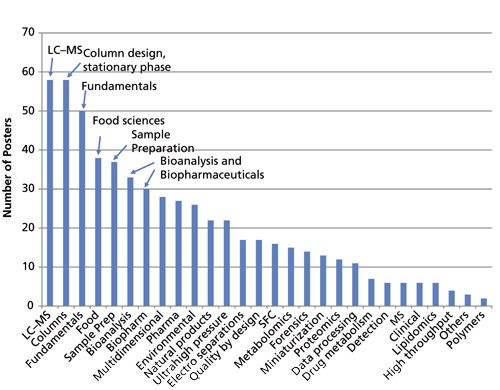
The tradition of Best Poster Award sponsored by Agilent Technologies at HPLC conferences continued in Geneva. This year 306 posters entered the competition, and 38 reviewers devoted a great deal of their time to judge the posters. Each poster was evaluated for inspiration (novelty and originality), scope (amount of work, technical quality, and execution of the experiments), and presentation (clarity, readability, and author’s explanation). There were 10 posters nominated in the PSA session (Monday and Tuesday) and another 10 were nominated in the PSB session (Wednesday and Thursday) to enter the second round evaluation, where each nominee gave a 5-min oral presentation on their posters. Then, 11 reviewers (different from the first round reviewers) evaluated these oral presentations to select the final awardees. Five posters from the PSA session were given the Best Poster Award while six posters from the PSB session were awarded because of a tie in the fifth place. These 11 final awardees are listed in Table II. It is interesting to note that eight out of the 11 winning posters were presented in the top seven poster session topic areas mentioned above.
The 11 Best Poster Awards were presented at the closing session on Thursday afternoon by the symposium chairman Gérard Hopfgartner and Tom van de Goor, PhD, of Agilent Technologies (Figure 10). Each winner received a cash prize of 500 Swiss francs (CHF). The final winners and the nominees of the final round come from 11 countries and represent the best research in the field of HPLC around the world.

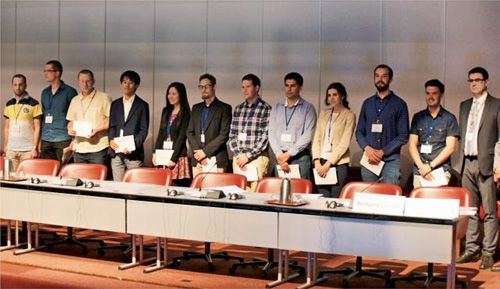
Conclusions
HPLC 2015 was an eventful symposium bringing together researchers interested in separation science from around the globe. To borrow some words from Ron Majors, the overall impression of the conference was “evolutionary” rather than “revolutionary.” The majority of the presentations provided information on steps forward with improvements in existing technologies and coupling multiple techniques to meet the challenges of complex separations. As mentioned, however, there were several presentations that offered insight into promising new technologies that might, in fact, become revolutionary in the near future. The most evident trend was the focus on large-molecule separations. The complexity of such separation challenges has necessitated improvements in existing technologies and the coupling of multiple techniques to gain as much information as possible with minimal time and effort. This trend is expected to drive innovation and will continue to be discussed in future HPLC and related symposia.
Upcoming Meetings
The 43rd International Symposium of High Performance Liquid Phase Separations and Related Techniques takes place in Beijing, China, this month (September 21–25, 2015), chaired by Professor Guibin Jiang of the Chinese Academy of Sciences. The 44th International Symposium of High performance Liquid Phase Separations and Related Techniques will be chaired by Professor Robert Kennedy of the University of Michigan and held June 19–24, 2016, in San Francisco, California.
Acknowledgments
Coverage of such a large symposium is impossible without a great amount of assistance. The authors would like to acknowledge the invaluable assistance from William Barber, PhD (Agilent Technologies), Professor Dwight Stoll (Gustavus Aldophus College), and Professor Alberto Cavazzini (University of Ferrara) for their kind permission to discuss their contributions. In addition, we’d like to thank Stacy Shollenberger and Gaurang Parmar (Sigma-Aldrich/Supelco) as well as Laura Bush (LCGC), James Heaton, PhD, Professor David McCalley (University of the West of England), and Professor Gert Desmet (Vrije Universiteit Brussel) for providing notes and discussions regarding content of various sessions. Finally, we’d like to thank Ron Majors for valuable discussions regarding the content and format of the present article.
References
(1) J. Heaton and D. McCalley, “Some Factors that Can Lead to Poor Peak Shape in Hydrophilic Interaction Chromatography, and Possibilities for Their Remediation,” presented at the 43rd International Symposium of High Performance Liquid Phase Separations and Related Techniques (HPLC 2015), Geneva, Switzerland, 2015.
(2) T. Farkas, L. Loo, L. Abadilla, M. Chitty, I. Rustamov, and T. Tran, “Has Core-shell Particle Technology Reached Maturity?” presented at 43rd International Symposium of High Performance Liquid Phase Separations and Related Techniques (HPLC 2015), Geneva, Switzerland, 2015.
(3) D.S. Bell, LCGC North Am.33(6), 386–395 (2015).
(4) W. Barber, T.-C. Wei, W. Chen, A. Mack, J. Liu, M. Dittmann, and X. Wang, “Next Generation Superficially Porous Particle Technology: Highly Ordered Pore Structures Formed By Pseudomorphic Transformation,” presented at 43rd International Symposium of High Performance Liquid Phase Separations and Related Techniques (HPLC 2015), Geneva, Switzerland, 2015.
(5) A. Cavazzini, O. Ismail, A. Ciogli, C. Villani, F. Gasparrini, D. Kotoni, D.S. Bell, and N. Marchetti, “Considerations on the Kinetic Performance of Columns Packed with New 1.9 μm Fully Porous Particles of Narrow Particle Size Distribution,” presented at 43rd International Symposium of High Performance Liquid Phase Separations and Related Techniques (HPLC 2015), Geneva, Switzerland, 2015,
(6) D. Stoll, D. Harmes, E. Wagner-Rousset, S. Fekete, D. Guillarme, and A. Beck, “Online Selective Comprehensive Two-Dimensional Liquid Chromatography-Mass Spectrometry for Efficient, High Resolution Characterization of Monoclonal Antibodies,” presented at 43rd International Symposium of High Performance Liquid Phase Separations and Related Techniques (HPLC 2015), Geneva, Switzerland, 2015.
(7) J.-P. Chervet, L. Rieux, A. Kraj, H.-J. Brouwer, “Controlled Reduction of Disulfide Bonds in Protein Therapeutics Using an Electrochemical Reactor Cell Online with MS,” presented at the 43rd International Symposium of High Performance Liquid Phase Separations and Related Techniques (HPLC 2015), Geneva, Switzerland, 2015.
(8) B. Karger, “Advanced Glycoprotein Structural Characterization Using Top-Down High Resolution CZE-MS,” presented at the 43rd International Symposium of High Performance Liquid Phase Separations and Related Techniques (HPLC 2015), Geneva, Switzerland, 2015.
(9) D. Stoll, J. Danforth, D. Harmes, E. Wagner, S. Fekete, D. Guillarme, and A. Beck, Anal. Chem. in press (2015).
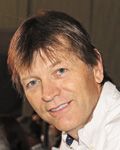
David S. Bellis a manager in pharmaceutical and bioanalytical research at Sigma-Aldrich/Supelco. With a B.S. degree from SUNY Plattsburgh and a PhD in Analytical Chemistry from The Pennsylvania State University, Dave spent the first decade of his career within the pharmaceutical industry performing analytical method development using various forms of chromatography and electrophoresis. During the past 15 years, working directly in the chromatography industry, Dave has focused his efforts on the design, development, and application of stationary phases for use in HPLC and hyphenated techniques. In his current role at Supelco, Dr. Bell’s main focus has been to research, publish, and present on the topic of molecular interactions that contribute to retention and selectivity in an array of chromatographic processes. Direct
correspondence to: dave.bell@sial.com

Xiaoli Wangis currently an R&D manager in Agilent CrossLab Group at Agilent Technologies in Wilmington, Delaware. He earned a PhD degree in Analytical Chemistry from the University of Minnesota in 2006 and then worked in the pharmaceutical industry at AstraZeneca for four years. Xiaoli joined Agilent Technologies in 2010 and his main focus has been the development of novel chromatographic columns.
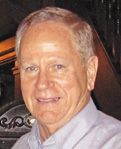
Ronald E. Majorsis the editor of “Column Watch,” an analytical consultant, and a member of LCGC’s editorial advisory board. Direct correspondence about this column to lcgcedit@lcgcmag.com
.
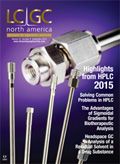

.png&w=3840&q=75)

.png&w=3840&q=75)



.png&w=3840&q=75)



.png&w=3840&q=75)












